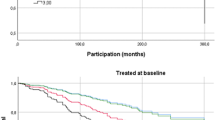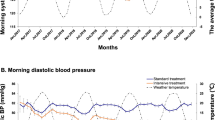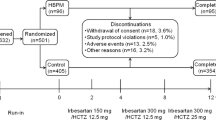Abstract
The objective of the study was to assess whether the publication of new guidelines, such as JNC VI 1997 and WHO/ISH 1999, and the development of new antihypertensive drugs have improved blood pressure (BP) control. A total of 150 patients (age 29–88, mean 66±11 years in 2001) who were followed at our hypertension clinic during 1991–2001 were retrospectively investigated. We compared the clinical characteristics of the patients in 2001 to those in 1991 and 1996, using the averaged BP determined at two occasions each year for our analysis. The average BP decreased during the 10 years between 1991 and 2001. When good BP control was defined as <140/90 mmHg, the rate of patients with good BP control increased from 31% in 1991 to 43% in 1996, and to 57% in 2001 (P<0.001 vs 1991). Both younger (⩽64 years) and older (⩾65 years) patients showed similar improvement during these 10 years. In 2001, satisfactory BP control (<130/85 mmHg) was achieved in 24% of younger patients, which was significantly higher than the achievement in 1991 (10%, P=0.02). This improvement occurred at the same time as an increase in the prescription of Ca antagonists and angiotensin II antagonist. The patients with improved BP control during these 10 years (n=50) showed lower body mass index (BMI) and serum total cholesterol levels in 2001 compared to persistently uncontrolled patients (n=54). Furthermore, the change in BMI during these 10 years was significantly less in the patients with improved BP control than in the persistently uncontrolled patients. In conclusion, BP control improved in the 10 years studied, and it seems to be attributable to the more frequent use of the newer drugs such as angiotensin II antagonists and Ca antagonists, to lifestyle modification and also to the growth in awareness of the importance of strict BP control.
This is a preview of subscription content, access via your institution
Access options
Subscribe to this journal
Receive 12 digital issues and online access to articles
$119.00 per year
only $9.92 per issue
Buy this article
- Purchase on Springer Link
- Instant access to full article PDF
Prices may be subject to local taxes which are calculated during checkout



Similar content being viewed by others
References
Bittar N . Maintaining long-term control of blood pressure: the role of improved compliance. Clin Cardiol 1995; 18 (Suppl III): III12–III16.
Guidelines Subcommittee. World Health Organization–International Society of Hypertension Guidelines for the Management of Hypertension. J Hypertens 1999; 17: 151–183.
UK Prospective Diabetes Study Group. Tight blood pressure control and risk of macrovascular and microvascular complications in type 2 diabetes: UKPDS 38. BMJ 1998; 317: 703–713.
Amery A et al. Mortality and morbidity results from the European working party on high blood pressure in the elderly trial. Lancet 1985; 1: 1349–1354.
Hansson L et al. Effects of intensive blood-pressure lowering and low-dose aspirin in patients with hypertension: principal results of the hypertension optimal treatment (HOT) randomised trial. Lancet 1998; 351: 1755–1762.
Staessen JA et al. Randomized double-blind comparison of placebo and active treatment for older patients with isolated systolic hypertension. Lancet 1997; 350: 757–764.
The sixth report of the Joint National Committee on Prevention. Detection, Evaluation, and Treatment of High Blood Pressure. Arch Intern Med 1997; 157: 2413–2446.
Lloyd-Jones DM et al. Differential control of systolic and diastolic blood pressure. Factors associated with lack of blood pressure control in the community. Hypertension 2000; 36: 594–599.
Burt VL et al. Trends in the prevalence, awareness, treatment, and control of hypertension in the adult US population. Data from the health examination surveys, 1960 to 1991. Hypertension 1995; 26: 60–69.
Pavlik VN et al. Hypertension awareness and control in an inner-city African-American sample. J Hum Hypertens 1997; 11: 277–283.
Joffres MR et al. Awareness, treatment, and control of hypertension in Canada. Am J Hypertens 1997; 10: 1097–1102.
Erdine S . How well is hypertension controlled in Europe? J Hypertens 2000; 18: 1348–1349.
Primatesta P, Brookes M, Poulter NR . Improved hypertension management and control. Results from the health survey for England 1998. Hypertension 2001; 38: 827–832.
Reyes-Gibby CC, Aday LA . Prevalence of and risk factors for hypertension in a rural area of the Philippines. J Community Health 2000; 25: 389–399.
Knight EL et al. Predictors of uncontrolled hypertension in ambulatory patients. Hypertension 2001; 38: 809–814.
Persson M et al. 1999 WHO/ISH guidelines applied to a 1999 MONICA sample from northern Sweden. J Hypertens 2002; 20: 29–35.
Ibrahim MM et al. Hypertension prevalence, awareness, treatment, and control in Egypt. Results from the Egyptian national hypertension project (NHP). Hypertension 1995; 26: 886–890.
Cuspidi C et al. Trends in hypertension control and left ventricular hypertrophy over three years. Ital Heart J 2002; 3: 514–519.
Hajjar I, Kotchen TA . Trends in prevalence, awareness, treatment, and control of hypertension in the United State, 1988–2000. JAMA 2003; 290: 199–206.
Dahlöf B et al. Morbidity and mortality in the Swedish trial in old patients with hypertension (STOP-Hypertension). Lancet 1991; 338: 1281–1285.
Peterson JC et al. Blood pressure control, proteinuria and the progression of renal diseases. The modification of diet in renal disease study. Ann Intern Med 1995; 123: 754–762.
Saeed AAW et al. Prevalence of hypertension and sociodemographic characteristics of adult hypertensives in Riyadh City, Saudi Arabia. J Hum Hypertens 1996; 10: 583–587.
Kim JS, Kim SJ, Jones DW, Hong YP . Hypertension in Korea: a national survey. Am J Prev Med 1994; 10: 200–204.
Jokiniitty JM et al. Prediction of blood pressure level and need for antihypertensive medication: 10 years of follow-up. J Hypertens 2001; 19: 1193–1201.
Appel LJ et al. A clinical trial of the effects of dietary patterns on blood pressure. N Engl J Med 1997; 336: 1117–1124.
Kastarinen MJ et al. Trends in blood pressure levels and control of hypertension in Finland from 1982 to 1997. J Hypertens 1998; 16: 1379–1387.
Guerrero-Romero F, Rodríguez-Morán M, Sandoval-Herrrera F, Alvardo-Ruiz R . Prevalence of hypertension in indigenous inhabitants of traditional communities from the north of Mexico. J Hum Hypertens 2000; 14: 555–559.
Whelton PK . Epidemiology of hypertension. Lancet 1994; 344: 101–106.
Burt VL et al. Prevalence of hypertension in the US adult population. Results from the third national health and nutrition examination survey, 1988–1991. Hypertension 1995; 25: 305–313.
Leer EM, Seidell JC, Kromhout D . Levels and trends in blood pressure and prevalence and treatment of hypertension in the Netherlands, 1987–1991. Am J Prev Med 1994; 10: 194–199.
Lang T et al. Prevalence and therapeutic control of hypertension in 30000 subjects in the workplace. Hypertension 2001; 38: 449–454.
The Trials of Hypertension Prevention Collaborative Research Group. Effects of weight loss and sodium reduction intervention on blood pressure and hypertension incidence in overweight people with high-normal blood pressure. Arch Intern Med 1997; 157: 657–667.
The Trials of Hypertension Prevention Collaborative Research Group. The effects of nonpharmacologic interventions on blood pressure of persons with high normal levels. JAMA 1992; 267: 1213–1220.
Whelton PK et al. Sodium reduction and weight loss in the treatment of hypertension in older persons: a randomized controlled trial of nonpharmacologic interventions in the elderly (TONE). JAMA 1998; 279: 839–846.
Kroke A, Bergmann M, Klipstein-Grobusch K, Boeing H . Obesity, body fat distribution and body build: their relation to blood pressure and prevalence of hypertension. Int J Obesity 1998; 22: 1062–1070.
Ministry of Health, Labour and Welfare, Japan. The National Nutrition Survey in Japan, 2001. Dai-ichi Shuppan Press: Tokyo, 2003, 182.
Glorioso N et al. Effect of the HMG-CoA reductase inhibitors on blood pressure in patients with essential hypertension and primary hypercholesterolemia. Hypertension 1999; 34: 1281–1286.
Glynn RJ et al. Use of antihypertensive drugs and trends in blood pressure in the elderly. Arch Intern Med 1995; 155: 1855–1860.
Ambrosioni E et al. Patterns of hypertension management in Italy: results of a pharmacoepidemiological survey on antihypertensive therapy. J Hypertens 2000; 18: 1691–1699.
Amar J et al. Hypertension in high-risk patients: beware of the underuse of effective combination therapy (results of the PRATIK study). J Hypertens 2002; 20: 779–784.
Haider AW, Larson MG, Franklin SS, Levy D . Systolic blood pressure, diastolic blood pressure, and pulse pressure as predictors of risk for congestive heart failure in the Framingham Heart Study. Ann Intern Med 2003; 138: 10–16.
SHEP Cooperative Research Group. Prevention of stroke by antihypertensive drug treatment in older persons with isolated systolic hypertension. JAMA 1991; 265: 3255–3264.
Author information
Authors and Affiliations
Corresponding author
Additional information
This study was presented at the 19th Scientific Meeting of the International Society of Hypertension in June 23–27, 2002, Prague, Czech Republic
Rights and permissions
About this article
Cite this article
Ohta, Y., Tsuchihashi, T., Fujii, K. et al. Improvement of blood pressure control in a hypertension clinic: a 10-year follow-up study. J Hum Hypertens 18, 273–278 (2004). https://doi.org/10.1038/sj.jhh.1001666
Received:
Revised:
Accepted:
Published:
Issue Date:
DOI: https://doi.org/10.1038/sj.jhh.1001666
Keywords
This article is cited by
-
Self-monitoring urinary salt excretion device can be used for controlling hypertension for developing countries
Clinical Hypertension (2019)
-
To what extent do prescribing practices for hypertension in the private sector in Zimbabwe follow the national treatment guidelines? An analysis of insurance medical claims
Journal of Pharmaceutical Policy and Practice (2017)
-
A review on prescribing patterns of antihypertensive drugs
Clinical Hypertension (2015)
-
Estimated urinary salt excretion by a self-monitoring device is applicable to education of salt restriction
Hypertension Research (2015)
-
Chapter 5. Treatment with antihypertensive drugs
Hypertension Research (2014)



